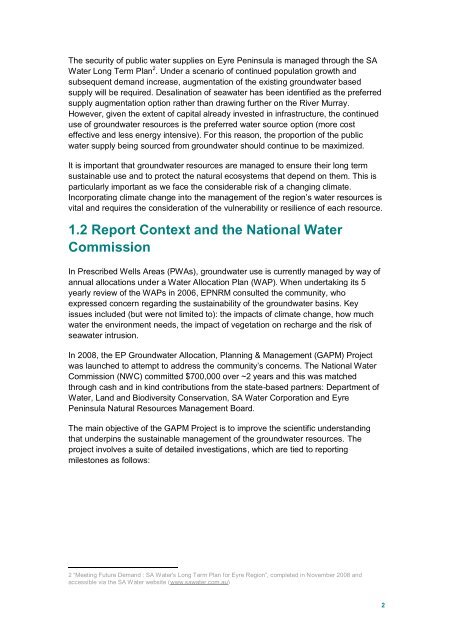Saltwater intrusion in Southern Eyre Peninsula, December 2009
Saltwater intrusion in Southern Eyre Peninsula, December 2009
Saltwater intrusion in Southern Eyre Peninsula, December 2009
You also want an ePaper? Increase the reach of your titles
YUMPU automatically turns print PDFs into web optimized ePapers that Google loves.
The security of public water supplies on <strong>Eyre</strong> Pen<strong>in</strong>sula is managed through the SA<br />
Water Long Term Plan 2 . Under a scenario of cont<strong>in</strong>ued population growth and<br />
subsequent demand <strong>in</strong>crease, augmentation of the exist<strong>in</strong>g groundwater based<br />
supply will be required. Desal<strong>in</strong>ation of seawater has been identified as the preferred<br />
supply augmentation option rather than draw<strong>in</strong>g further on the River Murray.<br />
However, given the extent of capital already <strong>in</strong>vested <strong>in</strong> <strong>in</strong>frastructure, the cont<strong>in</strong>ued<br />
use of groundwater resources is the preferred water source option (more cost<br />
effective and less energy <strong>in</strong>tensive). For this reason, the proportion of the public<br />
water supply be<strong>in</strong>g sourced from groundwater should cont<strong>in</strong>ue to be maximized.<br />
It is important that groundwater resources are managed to ensure their long term<br />
susta<strong>in</strong>able use and to protect the natural ecosystems that depend on them. This is<br />
particularly important as we face the considerable risk of a chang<strong>in</strong>g climate.<br />
Incorporat<strong>in</strong>g climate change <strong>in</strong>to the management of the region’s water resources is<br />
vital and requires the consideration of the vulnerability or resilience of each resource.<br />
1.2 Report Context and the National Water<br />
Commission<br />
In Prescribed Wells Areas (PWAs), groundwater use is currently managed by way of<br />
annual allocations under a Water Allocation Plan (WAP). When undertak<strong>in</strong>g its 5<br />
yearly review of the WAPs <strong>in</strong> 2006, EPNRM consulted the community, who<br />
expressed concern regard<strong>in</strong>g the susta<strong>in</strong>ability of the groundwater bas<strong>in</strong>s. Key<br />
issues <strong>in</strong>cluded (but were not limited to): the impacts of climate change, how much<br />
water the environment needs, the impact of vegetation on recharge and the risk of<br />
seawater <strong><strong>in</strong>trusion</strong>.<br />
In 2008, the EP Groundwater Allocation, Plann<strong>in</strong>g & Management (GAPM) Project<br />
was launched to attempt to address the community’s concerns. The National Water<br />
Commission (NWC) committed $700,000 over ~2 years and this was matched<br />
through cash and <strong>in</strong> k<strong>in</strong>d contributions from the state-based partners: Department of<br />
Water, Land and Biodiversity Conservation, SA Water Corporation and <strong>Eyre</strong><br />
Pen<strong>in</strong>sula Natural Resources Management Board.<br />
The ma<strong>in</strong> objective of the GAPM Project is to improve the scientific understand<strong>in</strong>g<br />
that underp<strong>in</strong>s the susta<strong>in</strong>able management of the groundwater resources. The<br />
project <strong>in</strong>volves a suite of detailed <strong>in</strong>vestigations, which are tied to report<strong>in</strong>g<br />
milestones as follows:<br />
2 “Meet<strong>in</strong>g Future Demand : SA Water's Long Term Plan for <strong>Eyre</strong> Region”, completed <strong>in</strong> November 2008 and<br />
accessible via the SA Water website (www.sawater.com.au)<br />
2

















